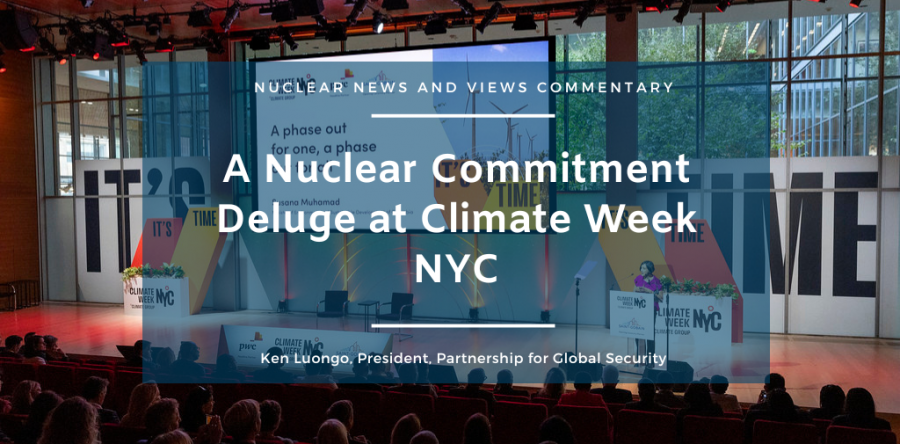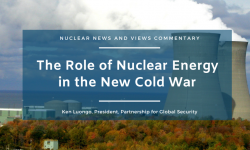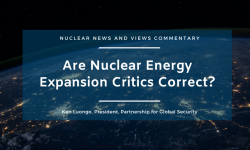The nuclear energy advocacy machine churned harder than Hurricane Helene at the recent Climate Week in New York City. The question is whether the collective commitments made there will generate the gale of actions necessary to triple nuclear power deployment by 2050. Because that objective faces some serious headwinds.
Early in the week, fourteen major banks and financial institutions offered an “expression of support” for the “call to action” to significantly expand nuclear energy that was endorsed at COP28 by over two dozen nations.
Included in the group were American, Canadian, European, and Middle Eastern financial institutions. This is a major step forward given that some previous ESG-focused financial funds excluded nuclear power as a clean energy technology.
Still, there was a nebulous nature to the financial commitment, as support for a call to action is fairly airy, and there was no clear backing for a specific project or nuclear technology.
There also was a conspicuous lack of a commitment from the U.S. government to financially partner with the private sector to make American nuclear energy competitive and deployable at the scale that the COP28 commitment contemplates.
President Biden’s Senior Advisor for International Climate Policy, declared that “I know we can make it happen – as long as we work together.” But the content of that togetherness was hard to find.
The Biden administration certainly deserves credit for delivering billions of dollars to keep existing reactors running, reopen decommissioned nuclear plants, support reactor exports to allied nations, and develop next-gen reactors.
But there is no order book for new nuclear plants in the U.S. and no clear strategy for the domestic and international market expansion that is the necessary foundation for success.
By contrast, Sweden’s Deputy Prime Minister was very specific. She noted that her government is exploring new financial models to deal with the high cost of nuclear projects after releasing a roadmap that called for two new nuclear plants. She stated that, “the Swedish government is exploring a proposed financing model which includes government-backed loans, Contracts-for-Differences (CfDs) and risk sharing mechanisms.”
Not to be outdone by New York, the Paris-based OECD Nuclear Energy Agency brought together 21 countries, including governments and industry, that committed to, “cooperate to fully unlock the potential for nuclear energy by taking measures that enable…construction of new nuclear capabilities and early deployment of SMRs.”
Many of the countries attending that event, including Bulgaria, Canada, Czechia, France, Hungary, Korea, the Netherlands, Poland, Romania, Sweden, Turkey, and the U.K. have specific plans for new nuclear energy deployment.
While that U.S. was a party to that NEA declaration it does not have any new nuclear power plants being prepared for construction. However, the U.S. did release a new Advanced Nuclear Commercial Liftoff analysis at the end of the NY climate event.
This report focuses on opportunities for large and small American reactors, including electricity load growth that is being accelerated by AI, data centers, manufacturing, and overall electrification.
One interesting feature of the report is the concern it expressed about the “lack of learning” in the U.S. commercial nuclear sector related to the fact that there are over 50 unique reactor designs. This implies that there needs to be a rapid winnowing of the plethora of next-gen reactors currently under development, lest they suffer the same fate.
Another item of interest is the clear call for an “order book” for the future. Here, the major challenges are diagnosed as financial backing and efficient project delivery. Both are major and long-standing problems that will not be easily remedied. That is why a strategy for success is so desperately required.
Unaddressed in that report is the challenge posed by nuclear power competitors, including China, Russia, and South Korea, all of which can build reactors with comparable power outputs to America’s while charging less and reducing build times.
Also left unexamined is the requirement for a targeted approach to identifying international markets, particularly for smaller reactors, and the range of support that will be necessary to allow a new nation to effectively deploy nuclear power. Engagement alone, which seems to be the metric of choice, is not sufficient.
The inability to develop a strategic plan now, can allow the authoritarian governments of Russia and China to gain control over the international nuclear market.
This geopolitical perspective was surprisingly missing from the New York climate conversation. This, in part, may be because neither Russia nor China were active in the myriad nuclear announcements and events.
But there also is an underlying view among some climate experts that the clean output of nuclear energy from any provider is the prize. The reality is that the source of the technology matters for geopolitical and global security reasons and these issues need to be a larger part of the nuclear growth dialogue.
What New York Climate Week made clear is that nuclear energy now has the wind at its back, but the commitments made there may amount to just talk. Hot air can generate lift-off but what’s needed is a chain of concrete projects that can fuel the flight.
Ken Luongo, President, Partnership for Global Security





